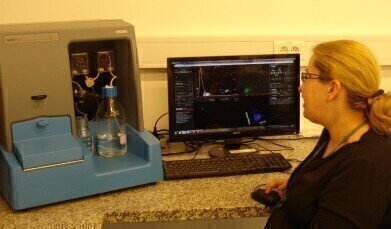Laboratory Products
Nanoparticle Tracking Analysis used to Characterise Inorganic Nanopowders and Colloids
Nov 12 2013
NanoSight reports on how Nanoparticle Tracking Analysis, NTA, is being implemented for the characterisation of various inorganic nanopowders and colloids synthesised in the Institute of High Pressure Physics at the Polish Academy of Sciences in Warsaw.
The Institute of High Pressure Physics (IHPP) was founded in 1972 by the Polish Academy of Sciences. The original focus was on high-pressure studies of semiconductors. Now, research covers ceramics, HTc superconductors, biological materials (high-pressure studies of protein folding, and high pressure food processing) and the plasticity of metals (hydroextrusion). The common axis of these studies is the use of high pressure, both as a research tool (a perturbation like temperature or magnetic field) and as a technological method (high-pressure sintering, high-pressure growth of crystals).
Agnieszka Opalinska is a research chemist working on the synthesis and practical applications of nanopowders for use in medicine, optics, optoelectronics, pharmacy and cosmetics. The Institute has developed a microwave, solvothermal technology which has enabled the group to very rapidly obtain homogenous and phase-pure nanoparticles including hydroxyapatite, zinc oxide and zirconium oxide. The size and shape of these nanopowders are easy to manipulate and may be functionalised with organic molecules. With a specialty in the preparation of colloidal solutions too, the group needs accurate and easy-to-use methods of particle characterisation.
Proper characterisation of nanostructure of powders is the key stage for the process. The Institute makes several measurements including nanopowder morphology, density, specific surface area, phase composition and crystalite size, all of which are made on dry powder samples. For the past two years, the Institute has used both NTA and DLS to produce complementary sizing results. However, when making the colloidal studies, NTA has a distinct advantage. Ms Opalinska said: "using NTA also gives us the concentration of particles. We like the use of video to be able to visualise the agglomeration process and to help us track the kinetics of the process."
Digital Edition
ILM 49.5 July
July 2024
Chromatography Articles - Understanding PFAS: Analysis and Implications Mass Spectrometry & Spectroscopy Articles - MS detection of Alzheimer’s blood-based biomarkers LIMS - Essent...
View all digital editions
Events
Jul 28 2024 San Diego, CA USA
Jul 30 2024 Jakarta, Indonesia
Jul 31 2024 Chengdu, China
ACS National Meeting - Fall 2024
Aug 18 2024 Denver, CO, USA
Aug 25 2024 Copenhagen, Denmark

-(1)-(1).jpg)


24_06.jpg)













